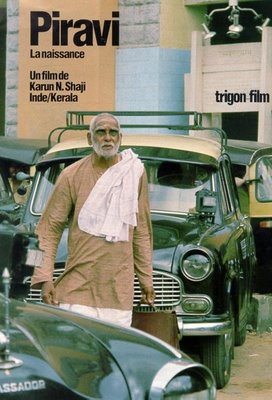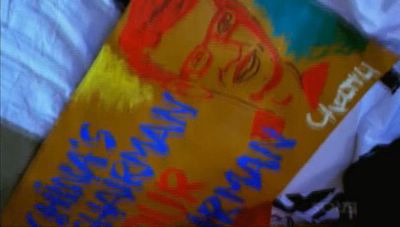Tuesday, October 21, 2008
Kerala youth get inspired by Naxalite Movement
Thallappavu and Gulmohar are just two of the most recent ones with a naxalite theme..
Com Varghese it seems did not shout his last slogan in vain... almost four decades after
his death "Inquilab Zindabad" is once again reverberating throughout Kerala .
You can know more about these movies in the below posts.
Gulmohar - Malayalam movie on Naxalite Maoist Movement in Kerala
Link to video
Review of Malayalam Movie Gulmohar
Once a revolutionary, always a revolutionary' should have been the tagline of Jayaraj's much talked about new Malayalam film Gulmohar. The acting debut of writer-director Ranjith has added to the curiosity value of this endeavour.
Scripted by Didi Damodaran (daughter of T Damodaran, the hit script writer of yesteryears) Gulmohar tells the story of a group of friends who were revolutionaries in their younger days. The tale is told from the point of view of Induchoodan (Ranjith), who now is settled as school teacher with his wife, two kids and mother-in-law.
As Induchoodan jogs down the memory lane, we get glimpse of their adventurous existence mostly lived on the edge as they took on the establishment and fought for the voiceless.
The script as such is packed with lot of layering. The current generation ridicules the suffering and the sacrifices their elders made to make the world a better place. Their relatives never empathised or appreciated the zeal with which they followed their heart's calling or even their sense of justice.
Induchoodan was an orphan (maybe it is used as a tool to justify why he is moved by the plight of others, as conveyed in a scene in the beginning where he tackles a complaint against an orphaned boy in the school) with only an elder sister to call his own. A person with a creative bent of mind, he uses his writing skills to propagate his ideas on revolution.
We fear that Induchoodan's character may go overboard any moment as any conventional multi-talented hero's would. But it is discreetly held back at the script level itself.
The narrative moves from the past to the present, giving us the story of Induchoodan's past and how his present is made.
Ranjith's performance does not look like he was the last minute replacement for the role of Induchoodan (Suresh Gopi [Images] was to play the role). He makes us feel that the part was written with him in the mind. He gives the impression that he has rehearsed well for the part.
Debutant Neenu Mathew is the other performance that impresses us.
Technically too, Gulmohar is in a league of its own, helping Jayaraj to bounce back in form.
Rediff.com
Wednesday, September 10, 2008
The Naxalites -Khwaja Ahmed Abbas, Mithun- A classic movie from the 1980's
Part 1 - 10 Min
Part 2 - 10 Min
Part 3 - 10 Min
Part 4 - 10 Min
Not sure if the complete movie is available...
Movie Review
The Naxalites (Mera Inquilab)

| Director | Khwaja Ahmed Abbus |
| Producer | Khwaja Ahmed Abbus |
| Music | Prem Dhawan |
| Starting | Mithun Chakraborty, Smita Patil,Nana Paliskar,Jalal Aaga,Tinu Anand, Dina Pathak, Imtiaz Khan,Dilip Raj,Pinchoo Kapoor,Yunis Parvej,Jaharlal Kaur Music: Prem Dhawan Officially Release: 1980 Language: Hindi and Bengali |
Review
 K.A ABBAS is a true visionary and his movies reflect the deprivations and vicissitudes of Indian masses, so don’t watch this if you don’t have stomach to watch a man being tortured as an ashtray by the cops with cigarette butts, famished peasants wondering in the lush green Bengal as they drop dead, a man selling his mother on the street as a whore, an orphan living in a grave in a cemetery, for these are the soulful but wrathful images which fill the screen in a requiem for the great Bengali nation in quest for their aspirations and deliverance in this veracious drama.
K.A ABBAS is a true visionary and his movies reflect the deprivations and vicissitudes of Indian masses, so don’t watch this if you don’t have stomach to watch a man being tortured as an ashtray by the cops with cigarette butts, famished peasants wondering in the lush green Bengal as they drop dead, a man selling his mother on the street as a whore, an orphan living in a grave in a cemetery, for these are the soulful but wrathful images which fill the screen in a requiem for the great Bengali nation in quest for their aspirations and deliverance in this veracious drama.
But do not expect sheer pity or divulging melodrama, as there is a genius at work here who does not want sympathy for his proud characters who want to shake the yokes of centuries of oppression but rather a passion for their dreams, which makes this a celebration for humanity. For this is the man who made the prestigious Dharti Ke Laal, the best account of the Bengal famine, as he created Shehar Or Sapna and Asman Mahal, two authentic classics of Hindi cinema, what a pity that intellect is not commercially palatable in art, so he only creates money spinners when he writes for the great showman Raj Kapoor, as Bobby and Awara are both penned by the same man. Unlike the eighties movies Mein Azaadhoun on a similar theme which become extremely melodramatic and sentimental at time.
oppression but rather a passion for their dreams, which makes this a celebration for humanity. For this is the man who made the prestigious Dharti Ke Laal, the best account of the Bengal famine, as he created Shehar Or Sapna and Asman Mahal, two authentic classics of Hindi cinema, what a pity that intellect is not commercially palatable in art, so he only creates money spinners when he writes for the great showman Raj Kapoor, as Bobby and Awara are both penned by the same man. Unlike the eighties movies Mein Azaadhoun on a similar theme which become extremely melodramatic and sentimental at time.
This demonstrates that cult classic like Naxalite should never be remade into a political travesty.
But this  is his final offering and it follows the trail of the infamous Naxal Bari movement which was crushed but couldn’t be finished by the hierarchy in Bengal, it was labeled as communism and anarchy when all it was trying to do was restore the basic human rights to a suffering populace, festering like an open sore on the face of India, this remains unchanged with starvation rampant in Assam, Bengal and Bihar but the only difference is likes of K.A Abbas have vanished from Indian cinema.
is his final offering and it follows the trail of the infamous Naxal Bari movement which was crushed but couldn’t be finished by the hierarchy in Bengal, it was labeled as communism and anarchy when all it was trying to do was restore the basic human rights to a suffering populace, festering like an open sore on the face of India, this remains unchanged with starvation rampant in Assam, Bengal and Bihar but the only difference is likes of K.A Abbas have vanished from Indian cinema.
The story wants to wake the conscience of a silent majority who accept tyranny without protest when a minority decide to fight the carnage with violence instead and give rise to a so called terrorist organization, the protagonists here are ordinary men and women with Mithun Chakraborty and Smita Patil as the leading figures and the plot follows the struggle s of its multiple figures as they render their humane sacrifices for a cause which they have swore to serve eternally.
s of its multiple figures as they render their humane sacrifices for a cause which they have swore to serve eternally.
The movie doesn’t treat itself as a doctrine in glorifying them, but rather analyses the milieu which induces their rebellion, yet once it establishes its motive, it doesn’t waste time in a political debate but quickly evolves into a script which is angry but relevant as the armed conflict ensues, unfortunately all true and what newspaper headlines reflected in the eighties and nineties, so it might be too uncomfortable for some viewers but cinematic heaven for others.

This is Mithun Chakraborty’s second Bollywood’s attempt after bagging the national award in Mrinal Sen’s Mrigaya and he is cast superbly as an orphaned grave dweller who lost his parents to the famine and is traumatized by memories of his mother having to sell her body to survive the streets of Calcutta, he is educated by a journalist into his past history ,when he is taken to watch Dharti Ki Laal, and he finds himself relating to the characters onscreen in a bewilderingly powerful sequence as Mithun nods off in boredom and then wakes up to the scenes folding out on the screen until he is passionately screaming in a genuine rage at the reality being shown in the great Dharti Ke Laal.

This was one of the earlier ventures of Smita Patil too, who is cast as an university student, a girl who wants justice for her brother, tortured to death by cops and has to prove her loyalty to the organization with murder, but it is admirable how convincingly she executes her unconventional role, as does Jalal Agha and Tinu Anand who respectively play a tribal villager and a manual rickshaw driver, both exploited at the hands of rural and urban tyrants.
The cinematography is metaphorical with simple images using earthly colors to heighten the mood of this angry drama but its level headedness is praise-worthy as it never betrays itself into becoming propaganda to resort to violence but emphasizes that if justice is denied to the poor in any civilization it will create dissension and rebellion, which is the message  conveyed in this story with a multiple character plot used for the framework in this great experiment, but the technical aspects remain extremely neat though you can see the maker economizing his meager budget, despite which he comes up with an admirable social drama which also works as an action adventure but most of all it remains true to its theme and that is to show the reality in a realistic manner. BRAVO!
conveyed in this story with a multiple character plot used for the framework in this great experiment, but the technical aspects remain extremely neat though you can see the maker economizing his meager budget, despite which he comes up with an admirable social drama which also works as an action adventure but most of all it remains true to its theme and that is to show the reality in a realistic manner. BRAVO!
An authentic Auteur or an Altruistic Agitator?
(A brief Introduction of Filmmaker)

A.K.Abbas (Left Most)
K. A .Abbas was possibly the most definitive and progressive activist in Indian literature and cinema. He is an intellectual who tries to redeem and solve a paradox without making a crucial issue into pseudo intellectual paradigm, his personal life akin to his public profile is affiliated with his passion for his causes versus the eponymous vitriolic opposition of his critics.
He was immensely talented, a true altruist and even his socialist themes are euphemisms for common sufferings. He made some deeply moving and disturbing realist and experimental cinema, it is expressionist but never abstract, in comparison to the avant-garde western influences of Andy Warhol and rolling stones, he is more in league with Di-Sica and Satyajit Ray, but he is always an existentialist who blames the hierarchy and the criminals with observing the truth without taking sides visibly.
He made the following note worthy unique classics:
Shehar aur sapna
Bambai Raat ki Bahoon Mein
Do Bhoond Paani
The Naxalites
Aasman Mahal
They are all dramatic satires colloquially dressed as mainstream cinema, they amalgamate the virtues and evils of materialism against socialism and are a debate on various stoically impassive crucial issues which most people will choose to ignore, while Abbas is not a renegade or a rebel, he definitely is a reformer who wants social modification at grass root level without destroying the ultra-structure of the defined establishment.
K. A. Abbas addresses the anger of youth in an endeavor to channel it into a calm conduit without denying the failures of the judiciary and democracy in India, he discusses lack of clean drinking water, truant itinerant homeless sleeping on the sidewalk, police cruelty, incompetent bureaucracy, colonial values still rampant in modern free India and in his last most memorable movie, he investigates and details the doomed and damning NAXALITE movement, which arose in Calcutta as a direct reaction to the delusional dissent of disillusioned youth who saw no change in a free India for the common man, instead the cloak of oppression had tightened.
The cast worked free of charge, including the two stars Smita Patil and Mithun Chakraborty, it was shot on real life locations and is rumored to be based on real life anecdotes. It is a final message from an auteur to a disgruntled and discontent social milieu, which persists despite the fact; he created this 30 years ago.
I have tried to do justice to this crucial but very significant movie in my review without discussing the rights or wrongs of the actions of its vitriolic, wrathful youth and their violent acts as I believe brutality breeds brutality and the right path to harmony lies in a society where all men are equal in the eyes of law and justice, whether it is a democracy or a totalitarian regime is besides the point, if justice is denied then a system has failed it's protagonists.
This is neither correctional nor sermonizing but a profound observation from a disillusioned mind who has seen his dreams shattered before his eyes.
I hope you enjoy this review of a cult classic, which is expressionist cinema in technique, and neo-realist in content, despite being minimalist as it is shot on a shoestring budget due to financial constraints. God bless the soul of Mr.Abbas.
Maadhukari.com
Saturday, July 29, 2006
Piravi (The Birth) (1988) - Review

Piravi (The Birth) (1988)
is an award-winning feature film directed by Shaji N. Karun. The film is in Malayalam. It stars Premji, Archana and Lakshmi Krishnamurthy. The film's music is composed by G. Aravindan. Piravi met with widespread critical acclaim upon release. The film was screened and very well received at many film festivals across the world. It won the Golden Lotus Award for Best Film at the National Film Awards in 1989.
Links
Piravi on Wikipedia
Piravi on IMDB
Comrades I do not have the movie right now
but I will try and get it soon and if possible.
I will host it online.
Tuesday, July 25, 2006
Maa Bhoomi - Our Land (Telgu )

*With sub-titles in English*
About the film:
Set during one of India's main peasant raisings, the Telangana insurrection between 1945 and 1951 in the pre-Independent state of Hyderabad, the Bengali director's first feature film tells the story of Chander's best-known novel from the peasant's point of view.
A young peasant, Ramaiah, rebels against the corrupt rule of the Nizam, and when his girl friend has to submit to the potentate's sexual coercion, Ramaiah leaves. He befriends a Marxist activist (the raising was CPI inspired) and participates in the independence struggle. When the peasants take over the village after the Independence, their anger boils over and they perpetrate a massacre.
In 1948 the Indian army marched into Hyderabad and suppressed the rising. Many of the ousted landlords returned to the power by becoming Congress officials, so that the peasants had to face the same struggle all over again.
This film is made in a documentary style inspired by Latin American political cinema but also uses Indian folk idioms such as Burra Katha style (the political education sequence with the union leader Maqbool). The film's view of rising is mostly an uncritical one, esp. in comparison with recent analysis by historians sympathetic to political groups currently working in Telangana.
Link for part I
Link for part II
Monday, July 17, 2006
Hazaaron Khwaishein Aisi - Movie Review

Hazaaron Khwaishein Aisi is the Lal salaam of sudhir mishra to a generation that grew up in an era where india's destiny could have been changed. A generation that dreamed to change the world, they fought with their parents, left what they had good education,money etc and went to remote villages to fight for an ideology.
Sudhir mishra tells the story about that generation and there thousand desires to a new generation, which is is ideologically empty and enjoying the benifits of the sacrifices made by the older generation without even thinking about them.But sudhir is not taking blatant sides in the movie, he does show his displeasure towards indira gandhi and the janatha party,but he is not rooting for the romantic idea of armed resistance.Things are told in a subtle way.
Unlike Govind nihlani's "Hazar chaurasi ki Maa" which presents the idea raw, sudhir presents it wraped in a beautiful love story.
Read full review here
Review by CPI(M-L)Liberation
Scenes from the Movie

A poster carried by the main protoganist bears a resemblence to Comrade
Charu Mazumdar

Vikrams wedding procession
For International Readers the Movie is available on Net Flix
Net Flix Link for Hazaaron Khwaishein Aisi
For Local readers the movie should be available at hong kong, burma bazaar
will not cost you more than 50-70 Rs
I am sorry I do not have the movie or the bandwidth to upload it but it
is available for download on bit-torrents for those want to download it
should try their luck there
Happy viewing.
Sunday, July 09, 2006
Dasi - The Bondswoman Part - 1 & 2 ( Telugu )
* With English Sub-Titles *

Set in 20's, it chronicles the unenviable life of a housemaid,
who was in custom then, came as a part of dowry to a rich
Zamindar's house. She goes through the
back breaking routine of household chores as well as
being expected to entertain the zamindar and his male guests.
When she gets pregnant, she is forced to abort. Narsing Rao, with the
help of his cameraman AK Bir, recreates the graceful lifestyle of the
privileged in limpid, sensuous images, as when the wife of the zamindar
is bathed and coiffeured by her maids, and contrasts it effectively
with his bleak suffocating world of the housemaid, whose world is not
her own.
The film that won Narsing Rao critical respect is
Daasi (Bonded Woman 1988).
This film won five National Awards, including the one
for Best Actress, won by Archana who played her role
with consummate skill.
Daasi Review at IMDB
Google Video Link for Part 1 (With English Subtitles )
Google Video Link for Part 2 (With English Subtitles )
Eventhough the movie is set in the 1920's ,this practice is still
prevalent in many parts of India today.
The only people who have fought tirelessly against this degrading
inhuman practice are the maoists and naxalites.

